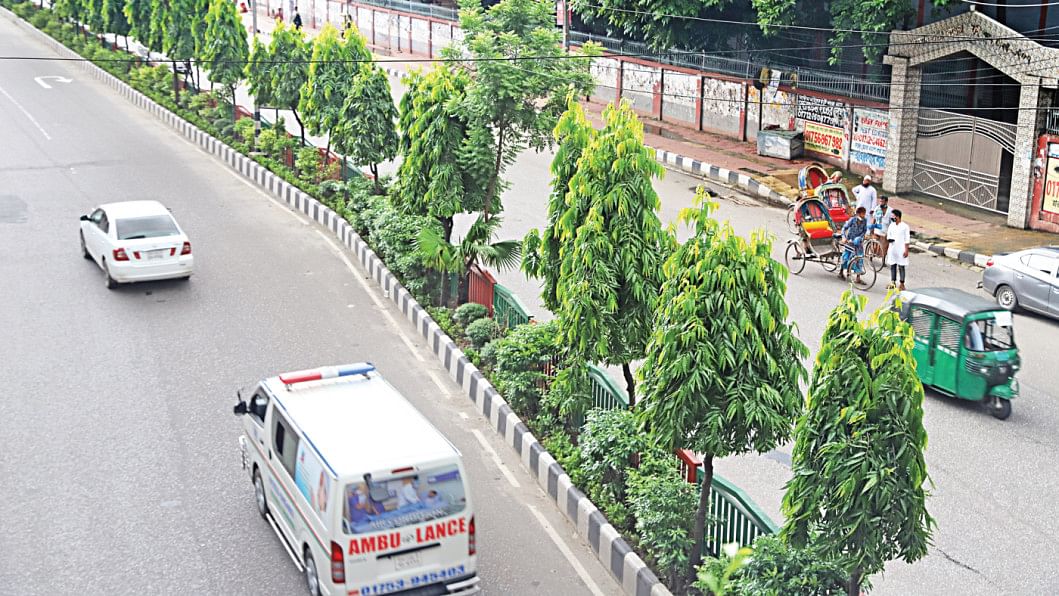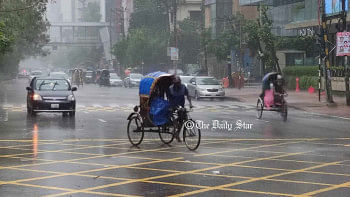Road Dividers in Dhaka: Exotic plants outnumber local species, finds survey

Majority of the plants -- 56 percent -- on the capital's road dividers are exotic species, which is detrimental to the environment and disrupting the ecosystem, found a recent survey.
According to the data, among the top 15 dominant plant species, nine are exotic and six are native. Plants of foreign origin are not suitable for the country's climate.
A research team, led by Mohammad Zashim Uddin, professor of botany at Dhaka University, conducted the survey and published a paper titled "Evaluation of Plant Species Diversity in the Road Dividers of Dhaka City" in the June edition of Bangladesh Journal of Plant Taxonomy, the official journal of Bangladesh Association of Plant Taxonomists.
Researchers and urban planners said due to high presence of exotic species, the country's native species are being lost day by day. Moreover, birds, butterflies, honey-bees, insects and other pollinators that depend on native species are also in danger.
They said the whole city is being occupied by exotic species, which is not conductive to Dhaka's environment, biodiversity and beautification. No integrated planning among different departments for tree plantation is the reason behind this problem.
In 2017, Roads and Highways Department had planted Chinese and Taiwanese bonsai bot trees on Airport Road for beautification, which caused controversy.
"In urban planning, it's basic knowledge that indigenous trees should be prioritised when planting. Foreign trees can't adapt to local environment in most cases, and they also have a great impact on biodiversity," said Adil Mohammad Khan, secretary general of Bangladesh Institute of Planners.
RESEARCH FINDINGS
The research team found a total of 90 plant species from dividers of 31 roads at 10 locations, including Uttara, Mirpur, Hatirpul-Panthapath, Dhanmondi-Azimpur, Hatirjheel, Rampura-Badda, Gulshan-Mohakhali, Kamalapur, Fakirapul-Gulistan, said Prof Zashim.
Seventy-eight percent of the species were classified as trees, 12 percent as shrubs, seven percent as herbs, and three percent as climbers.
Mimusops elengi (bakul), Polyalthia longifolia (debdaru), Leucaena leucocephala (epil-epil), Tabernaemontana divaricata (togor), and Swietenia mahagoni (mahogany) were the most abundant species.
Only togor is native among the five species; bakul and debdaru originates from the Indian subcontinent.
Most diversity was found at Hatirjheel and least was recorded at Baridhara-Badda area.
PROBLEMS OF EXOTIC SPECIES
The researchers said the higher number of exotic plants is perhaps because of ample availability of their saplings during plantation. An absence of plant taxonomic knowledge might also play a role.
"In most cases, plantation programmes are carried out by contractors. Unfortunately, they don't have the ability to differentiate native and exotic species," said Prof Zashim.
Most of the exotic trees are soft-wooded, which break down easily. These species may create huge hazards in a densely-populated city during natural disasters, and in most cases, they are not suitable for proper animal diversity, although some have aesthetic value, he said.
"The branching patterns of their roots, stems and canopy is not road-divider friendly. Trees fall every year during torrential rain with gusty wind and nor'westers…Sometimes, they become a source of grief for city dwellers, as people die due to falling trees every year," he added.
Adil Muhammad Khan also blamed the process of tree plantation. "We do most of the work through contractors, but we should include botanists with them for proper work," he said.
"We can plant exotics trees, but there should be a limit; 56 percent is quite significant, so we should rethink our process," He added.
RECOMMENDATIONS
New generation of students are being deprived of the opportunity to get acquainted with native species of flora and fauna, due to the abundance of exotic trees on road dividers, the researchers wrote.
"We have many indigenous ornamental plant species that are endangered…the current status of species diversity on road dividers needs to be addressed," they said.
They recommended creating a master plan for beautification using native species. In this case, local stakeholders, including city corporations, park and garden authorities, Rajuk, Public Works Department, forest department, and experts should be brought under one umbrella.
They also recommended replacing the existing exotics plants gradually.
Nurseries should be established under the forest department to tackle the challenge of finding saplings of native species, they said.
Contacted, Md Sirajul Islam, chief town planner of Dhaka South City Corporation, rejected the survey results.
He said, "This has not come to my knowledge, and it is not supposed to happen. The mayor has specific instructions for the engineering section to not plant any exotic or big trees on road dividers."
Undergraduate students of Botany department -- Abulais Shomrat, Md Siddiq Hasan, Md Robin Khan, Abdur Rahman Fahad and Md Al-Amin -- were co-authors of the research paper. University Grants Commission and Dhaka University provided financial support to conduct the work.


 For all latest news, follow The Daily Star's Google News channel.
For all latest news, follow The Daily Star's Google News channel. 



Comments